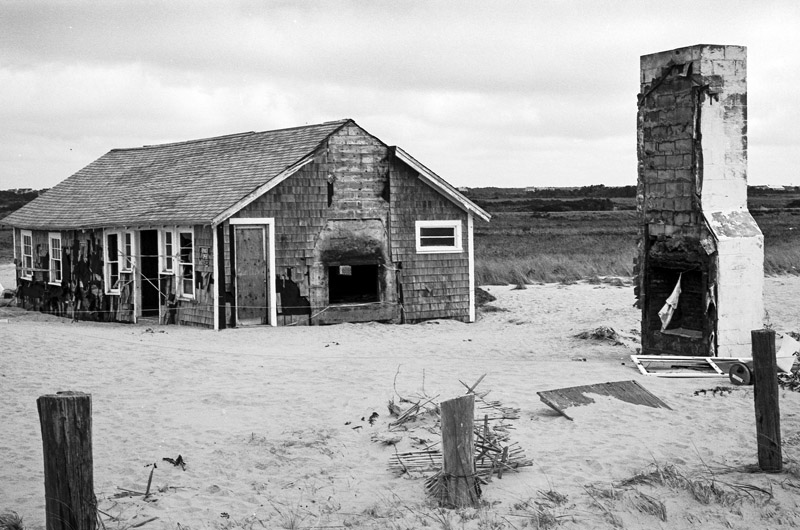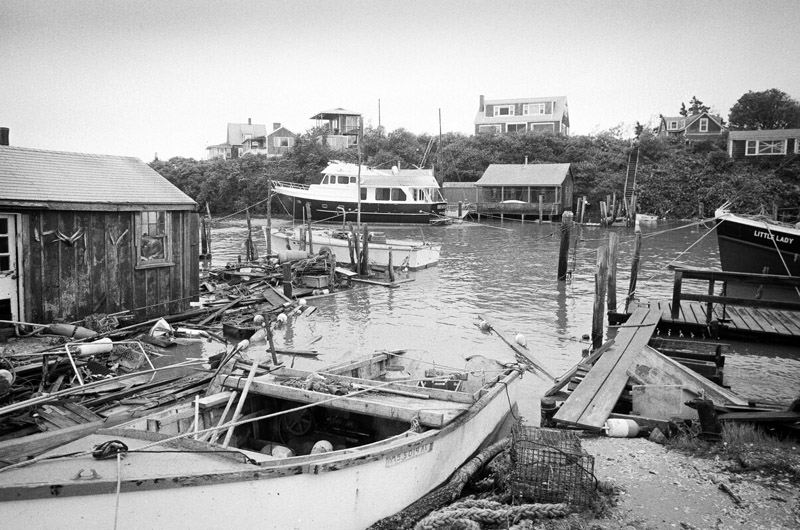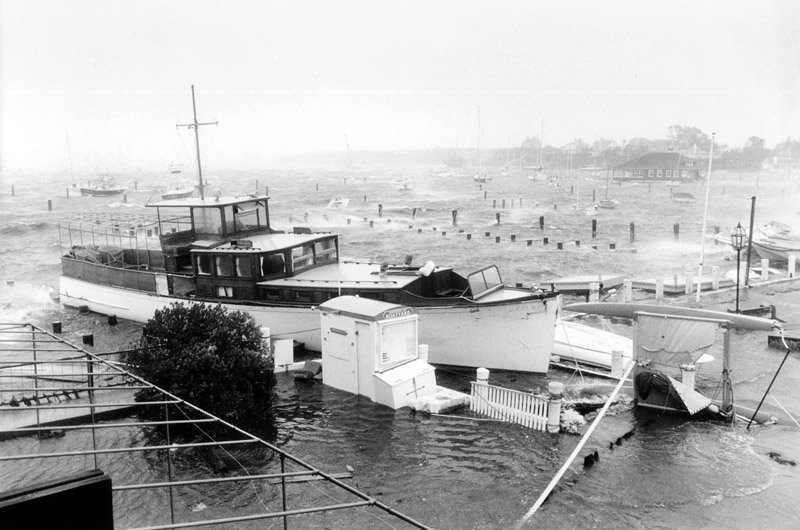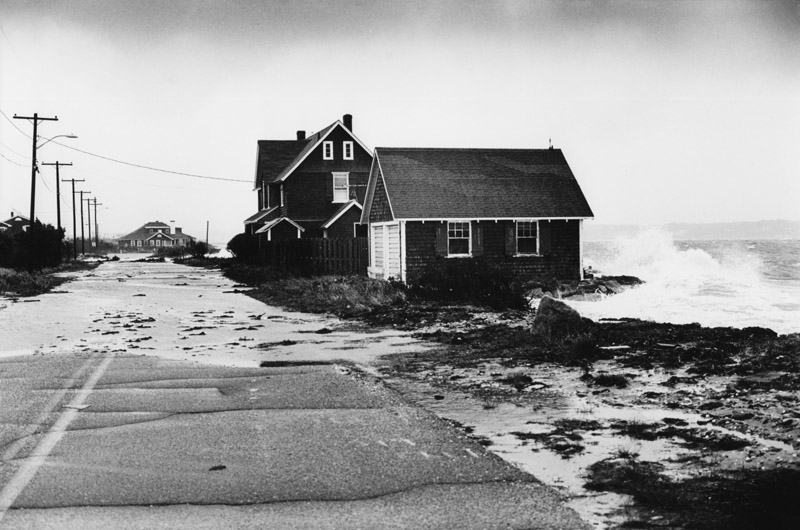In the hours before Hurricane Bob made landfall 25 years ago Friday, Islanders stocked up on ice and batteries, secured their boats and turned on their radios. Businesses boarded up windows, police officers knocked on doors in low-lying areas, and some 1,500 people poured into shelters across the Island.
It was the earliest hurricane in New England history and the second most expensive, after Hurricane Hugo two years earlier. It was also long overdue. Prior to a narrow brush with Hurricane Gloria in 1985, the Vineyard hadn’t received a direct hit since Hurricane Donna in 1960. And even that storm didn’t bring the kind of destruction that hurricanes Carol and Edna did in the summer of 1954.
By mid-afternoon the next day, the sun was out and crowds of people were assessing the damage. Edgartown Harbor lay in shambles, with 84 vessels beached, sunk or capsized. Ponds were torn open to the sea along the south shore, and roads from Chappaquiddick to Gay Head were littered with branches and wires. A few roofs were missing, and two feet of water lapped at the outside of the A&P in Vineyard Haven. But overall, the Island breathed a sigh of relief.
“Bob came through here very quickly,” Edgartown harbor master Charlie Blair recalled on a sunny morning this week. At the time of the storm, he was a charter captain and had seen his share of hurricanes on both land and sea. “It was going 34 miles an hour when it came through Edgartown, so it was really over in less than an hour,” he said. But that was long enough for 100-mile-per-hour winds to cripple the harbor and cause millions of dollars in property damage. “There were boats all over the place,” Mr. Blair said. “Boats broke loose, dragged down, crashed into docks.”
A sloop owned by his sister ended up far away on the path to the Edgartown Lightouse, still tethered to its 4,000-pound block, which also sat on dry land. Mr. Blair recalled his elation at finding his towboat Nisa just where he had left it in the harbor, with only a small dent where it had been struck by another boat.
Over the next two days, he joined the local effort in pulling the less fortunate boats from the beaches.
A seven-foot surge combined with an incoming tide had snapped or carried away many of the mooring lines (not everyone thought to extend their lines prior to the storm) and sent boats careening in all directions. The harbor was soon rebuilt, although a 10-foot minimum scope on the moorings remains in place today.
“We’re not set up for storms here,” Mr. Blair said, looking out over the yachts and sailboats that dot the harbor at this time of year. “We’ve got people packed in here like sardines. Everything is on a short scope.” And while he does his best to keep transient boats out of the harbor during storms, he believed preparation could only go so far. “Stripping all the canvas off all the boats, and putting extra lines in, that all helps,” he added. “But a true category three storm is going to destroy the harbor.”
The storm took even experienced captains by surprise, although the National Weather Service had been tracking it since the previous Friday. By Sunday, it had intensified to category three, based on its sustained wind speed, but was given only a 20 per cent chance of making landfall in the state. Preparations on the Island began in earnest Monday with announcements on local radion station WMVY and an early morning meeting among public safety officials.
“This was a storm that got a name Friday around noon and was on our doorstep Monday morning,” said Robert Thompson, a National Weather Service meteorologist who helped track the storm’s approach. “So that gave us limited time to prepare.” By the time Bob made landfall in Newport, R.I., it had weakened to a category two storm, but the eye passed just east of the Vineyard, bringing severe winds and high seas.
Very little rain fell during the storm (0.15 inches in Edgartown), but the damage from wind was evident everywhere. Many old-growth trees had come up at the roots, and major Island roads were blocked by a tangle of branches, poles and wires. Mytoi, the secluded Japanese garden on Chappaquiddick, including its towering black-pines, was swept bare, leading some to speculate the presence of a tornado or some kind of micro-burst.
The storm brought down 2,400 power lines across the Island (four times as many as Hurricane Gloria), with Chilmark suffering much of the damage. Gay Head didn’t lose a single electric pole, but remained in the dark for about a week while line and tree crews from as far as Oklahoma helped restore the rest of the system. Cuttyhunk also fared well, with its power lines having been buried some time before.
Trees were the main casualties across the Island. In the state forest, an estimated one million board feet of timber, mostly white pine, was felled by the heavy winds, leading to heightened concerns about forest fires in an exceptionally dry year. State budget cuts had limited the forest cleanup efforts, so trees and branches were simply thrown back into the woods.
Eleven days after the storm, President George Bush declared the state a national disaster area, opening the door to millions of dollars in federal disaster aid. Many had taken a lesson from Hurricane Gloria and kept a detailed inventory of the damage so they could apply for the federal aid and be reimbursed.
Early estimates placed the cost of the hurricane at around $5.5 million ($9.72 million in current dollars), including about $3.1 million ($5.48 million today) in private property damage. Statewide, the storm was valued at about $900 million ($1.59 billion today).
Islanders relied on radio, television and newspapers for coverage and updates. and many remained glued to their TVs until power went out on Monday. One writer at the Gazette recalled the moment his TV blinked off and looking out his window to see $6,000 worth of landscaping fly away in the storm. For many, the storm was a wakeup call for an Island always at risk, if not always on guard.
It was also the first major hurricane to come along since the Gazette transitioned to offset printing in 1975 — a process that made it much easier to print photographs and other content. With no power in Edgartown, a core production team flew to Nantucket to produce the Tuesday edition, which was devoted almost entirely to the storm. The paper’s coverage of Hurricane Bob was later nominated for a Pulitzer Prize.
Printed overnight at the Inquirer and Mirror and flown back on two airplanes, the Hurricane Bob edition sold out almost immediately and was followed by a second edition once power was restored on Thursday.
Photographer Alison Shaw, then director of graphics and design at the paper, recalled running with her negatives down the street to catch a ride to the airport on Tuesday, and working a triple shift that week to produce the two editions.
“That was the source of news,” she said. “You couldn’t go online and get news. The newspaper was it.”
She also recalled being stranded in Menemsha on the day of the storm, blocked in every direction by fallen debris. But the storm was just the beginning of Bob’s influence on the Island.
“The blip of the hurricane was so short and so intense,” she said. “I have more memories of the aftermath and getting the paper out than the hurricane itself.”
Over the following weeks, thousands of people put in extra hours to clear roads, salvage boats and help the Island recover. The sound of chainsaws filled the air, trucks were piled high with brush and equipment, and advertisements appeared everywhere for companies doing yard cleanup and carpentry.
The commotion left swarms of tree-dwelling bees in a foul mood, and Islanders often found themselves running for cover as they cleared brush or dropped off their garbage at the town landfills, all of which extended their hours after the storm.
Grocery stores lost much of their perishable food, and many crops died or were blown away. But travel to and from the Island suffered only a small dip on the day of the storm, and in a few weeks Hurricane Bob was already becoming a memory.
Perhaps the most lasting changes resulted from the pounding of waves and the lashing of salt spray along the south shore. Echoing the hurricanes of 1954, leaves from Edgartown to Gay Head turned brown (dried out from the salt and wind) and the Island experienced an early autumn when the leaves fell.
“Six weeks later we had spring,” said Chris Murphy, who weathered the storm at his camp in Chilmark and recalled the new buds on many species that autumn. “Then it froze.” The normal cycle resumed the following year.
Many south shore ponds, including Katama Bay, rose several feet during the surge and broke through to the sea — part of the natural process of shoreline change. Dunes all along the south shore disappeared, eventually to reform farther inland. Some barrier beaches moved back 300 feet or more.
Edgartown shellfish constable Paul Bagnall recalled preparing ahead of time by freeing nearly all of his cultured quahaugs from their grow-out bags to give them a fighting chance against the storm. Otherwise, he said, they would have washed up on the shore along with the bags and perished. Many of the shellfish were affected by changes in circulation in the bay and stopped growing. Others made it through, despite being swept northward and covered by at least two feet of sand.
Some areas of the bay saw an uptick in shellfishing after the storm. “The downside of that was that they all got harvested, because there were no grass beds left for them to hide in,” Mr. Bagnall said. “And a lot of them got windrowed out.”
The north shore remained relatively stable, although a powerful Halloween northeaster later in the year (the subject of the 2000 film The Perfect Storm) battered the Island, causing severe damage between Edgartown and Tisbury. Curiously, the storm was at least as intense Hurricane Bob, but received considerably less attention. Ms. Shaw believed it may have been a matter of timing, with Bob arriving at the height of summer with more warning and a name of its own. “So there’s all that hype leading up to it,” she said.
Some people this week played down the severity of Hurricane Bob, especially in light of hurricanes Carol and Edna, which lingered much longer and devastated the Island.
“We prepare all we can, but it’s never enough for a hurricane,” Mr. Blair said. “Bob was a little baby hurricane. If it had been anything like Carol, it would have taken us years to recover.”
A historic video and more photos from Hurricane Bob.















Comments (8)
Comments
Comment policy »